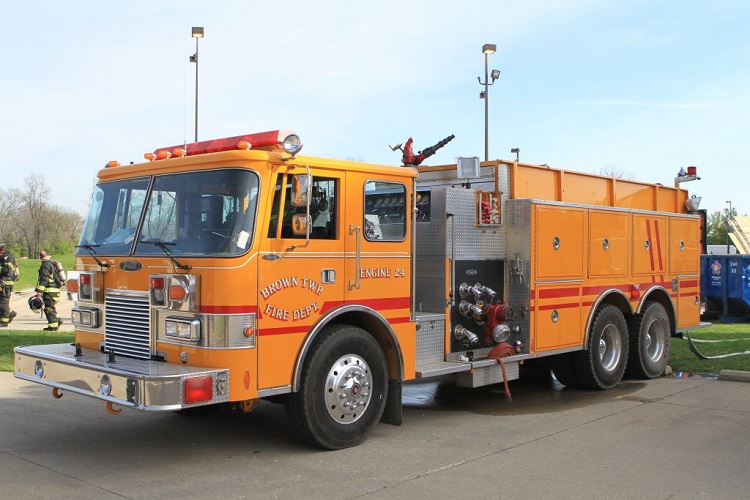

Photo by Tim Olk.
On May 4, 2017, former Jersey City (NJ) Fire Department Battalion Chief/Apparatus Supervisor William C. Peters presented a webcast on “The Basics of Apparatus Purchasing.”
This webcast guides the participant through the difficult process of specifying fire apparatus. It covers justification, the use of NFPA 1901, conducting research, options and features, boilerplate information to protect the purchaser, converting the manufacturer’s specifications into your own, controlling frills, holding a successful preconstruction conference, how to do a thorough final factory inspection, and delivery and acceptance.
Below, he answers some questions submitted by viewers.
Q: On older engines where rear-facing crew members are not in an enclosed cab, is there a time line for getting them replaced or taking them out of service? Is there anything that tells me if/when I have to take it out of service?
A: There are no time lines except Annex D, which states that apparatus that is 25 years old should be retired. The fully-enclosed cab requirement started in 1991; 25 years would be 2016.
Q: Do you think that the Annex D in NFPA 1901 will ever become a standard, not just an annex?
A: No, unfortunately, NFPA cannot require the retirement of apparatus; it can only be recommended.
Q: Are there any special considerations for 4WD apparatus?
A: Driveline angle and angle of approach and departure are a couple of things that come to mind. Most manufacuters are familiar with the requirements.
Q: Is pump performance the main issue with altitude? We are at 9,000 feet.
A: Pump performance and engine performance. Be sure to include your altitude in the spec! I did work for Los Alamos and they were at 8,200 feet!
Q: Will I hurt my ISO rating if I take the pump off a ladder truck when I order a new one? Here is what I have: Five frontline engines at 1,500 gpm. Water tank size no less than 750 gallons, three reserve engines at 1,500 gpm, 500 gallons; two frontline aerials at 2,000 gpm, 300 gallons; and one reserve aerial at 1,500 gpm, 300 gallons. For the ISO paperwork, we identified them as ladder companies and service companies, not quints.
A: It would appear that you have enough engines and ladder companies. I doubt that the removal of a pump on a ladder would have any impact on your rating, especially for the rating you identify them as trucks. When I was in Jersey City, none of the trucks had a pump. The same with FDNY.
Q: With the current EPA emission requirements, the interior of the cab has become cramped. In addition, the ground-to-cab floor height is getting higher. Do you see these negatives being addressed by the manufacturers in the future?
A: As I said, the manufacturers of the diesel engines are able to reduce the size of the emission equipment. Watch for the need for more room for seating. I’m not sure how the manufacturers are going to deal with that when it is a requirement.
Q: How many people do you recommend for a purchasing committee?
A: There are no hard-and-fast rules on a committee makeup. As I said, probably keeping it to maybe four people would be a good number depending on their experience.
Q: Why a single stage vs. a dual stage?
A: Single stage are lighter, cheaper, and easier to operate. As I said, the new diesel engines can easily make the pump test with a single-stage pump.
Q: With the use of brine to melt the snow and ice, what can a department do to protect the undercarriage?
A: Very good question! Manufacturers offer coated frame rails and crossmembers. In the “old days,” we used undercoating, a tar mixture; it wasn’t very effective. Also, if you use a frame liner, it is important to coat the surfaces between the rails.
Q: What’s your opinion on refurbished apparatus?
A: For a lightly used apparatus, a refurb is OK, especially if the unit has been well maintained. If it is a busy company, it might be more of a problem than it is worth. Don’t forget, the engine, trans, axles, and so on are all “X” amount of years old. Sometimes, parts are a problem because of age. Each case needs to be evaluated on its own. Also, when you get a refurb price, expect it to increase as they disassemble the unit!
Q: How much time is allowed between delivery and acceptance?
A: It depends on how much acceptance testing is required. If you don’t have special requirements, you can do the road test and see how it performs. If it is magrinal, I wouldn’t pay until it is fully loaded and tested. Also, if you do a mini-pump test and final inspection at the factory and your jurisdiction don’t have any special altitude problems, you probably don’t need to repeat the pump test.
Q: Can I access an outline printout of this webcast?
A: Bill asked we not make the slides available because of some of the photos used. You can view the webcast on demand for a full year. You can access it by using the same link, and we will send you and e-mail tomorrow letting you know.
 William C. Peters retired after 28 years with the Jersey City (NJ) Fire Department, having served the past 17 years as battalion chief/apparaut supervisor. He served as a voting member of the NFPA 1901 apparatus committee for several years and is the author of the Fire Apparatus Purchasing Handbook and numerous apparatus related articles.
William C. Peters retired after 28 years with the Jersey City (NJ) Fire Department, having served the past 17 years as battalion chief/apparaut supervisor. He served as a voting member of the NFPA 1901 apparatus committee for several years and is the author of the Fire Apparatus Purchasing Handbook and numerous apparatus related articles.

